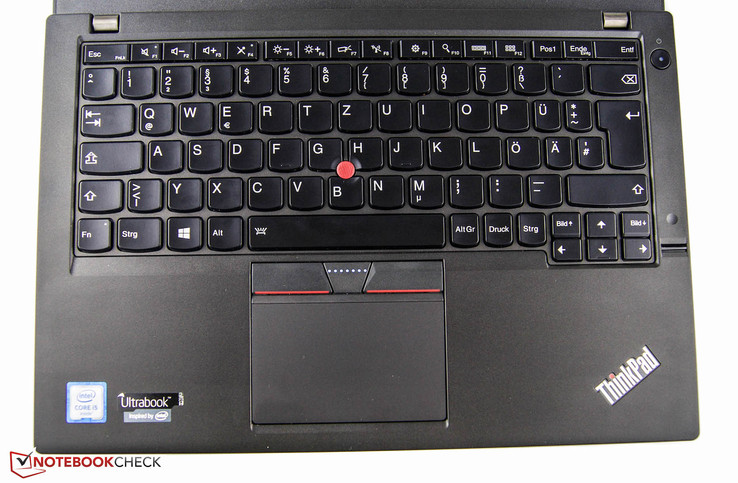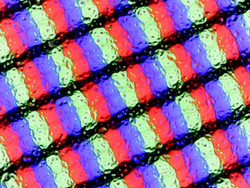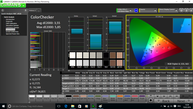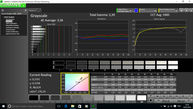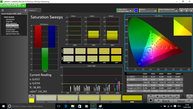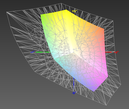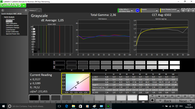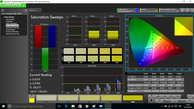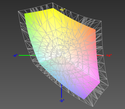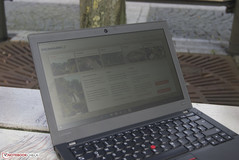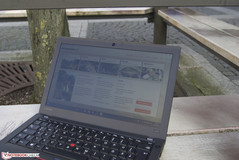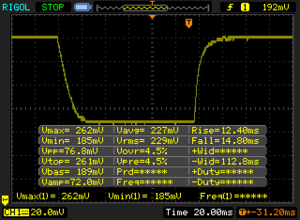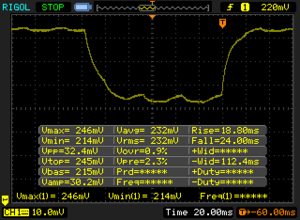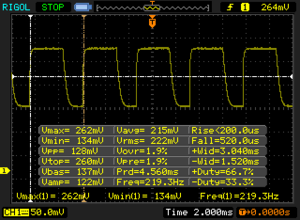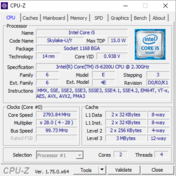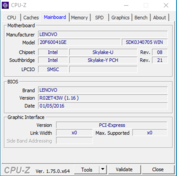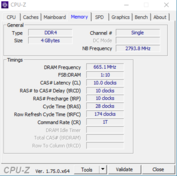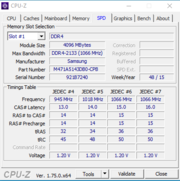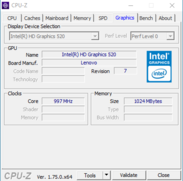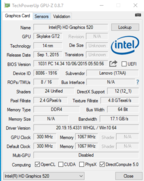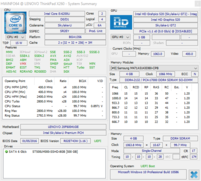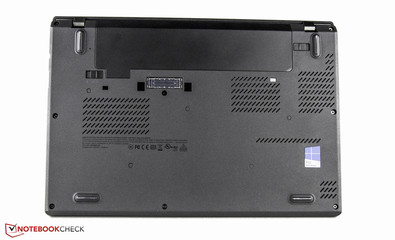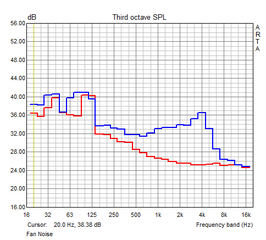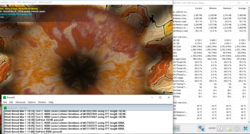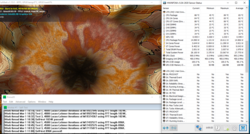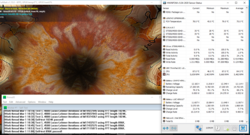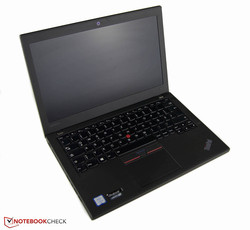Lenovo ThinkPad X260 (Core i5, WXGA) Notebook Review

For the original German review, see here.
After the presentation of the new ThinkPad models at CES 2016, we can now review Lenovo's new subnotebook. The ThinkPad X260 is supposed to be a companion for your business days. For this purpose, you get additional security features, a certified chassis stability as well as powerful hardware. Three versions of this new model are available. We have a look at the medium-spec configuration. This series starts at 1,200 Euros (~$1,335), but the price can climb all the way up to 1,675 Euros (~$1,863). Our version retails for 1,450 Euros (~$1,613).
We use the following rivals for a comparison: Dell Latitude E7250 and HP ProBook 820 G2. Those two notebooks are supposed to get Skylake updates as well (Dell Latitude E7270 and HP ProBook 820 G3) and we are going to review them. Also interesting are the differences to the familiar Lenovo ThinkPad X250 series.
Case
Lenovo uses a classic matte-gray plastic chassis for the ThinkPad X260. The surfaces are slightly rubberized, which improves the grip when you transport it. More precisely: The chassis is made of a fiberglass-reinforced compound. The design appears quite boxy, but almost all the edges are slightly rounded. The build quality is satisfying. Only the two hinges look a bit small, but they are very sturdy and prevent bouncing of the display very well. Two parts are not assembled perfectly at the front, so one element is slightly protruding. The lid is also sturdy in general and can only be pushed in slightly. Lenovo advertises the certification of the case according to the military standard MIL-STD-810G. It contains eleven tests, which are listed on the product homepage. These include humidity, pressure, temperatures and dust. The thickness of the small ThinkPad is pretty average at 2 cm (~0.8 in). The combination of thickness and weight (1.5 kg/~3.3 lb) ensure that it is no problem to store the test model in backpacks or other bags.
The maintainability is not very user-friendly. There are unfortunately no maintenance hatches. Similar to the Lenovo ThinkPad X250, you will have to remove the whole bottom cover. It is at least no problem to replace the external battery in a few simple steps.
Connectivity
Well equipped for the office. Besides the usual ports (3x USB 3.0, HDMI, Mini-DisplayPort, SD-card slot), the ThinkPad X260 offers a SmartCard reader, a fingerprint scanner as well as a SIM-slot for the optional WWAN module. Details for the WWAN/SIM option are listed in the spec sheet of this series. There is unfortunately no additional NFC chip. Particularly important: At the bottom is a docking port. The HDMI output supports resolutions of up to 4096x2160 pixels at 24 Hz; the Mini-DisplayPort on the other hand can drive 4096x2160 pixels at 60 Hz.
The port layout is convenient for right-handers. The majority of ports is quickly accessible at the front left side, so a mouse on the right side is not affected by peripherals. This can be an issue for left-handers, since the left area is rather occupied when you attach mDP adapters and cables.
Before we leave this section, we also have a look at the performance of the SD-card reader: We use our reference card Toshiba Exceria Pro SDXC 64 GB UHS-II. The average transfer rate is 62 MB/s when you copy pictures. The AS SSD benchmark determines 84.93 MB/s (seq. read) and 63.08 MB/s (seq. write).
Communication
There are up to three ways to establish an Internet connection. Wired networks can be used via a Gigabit-Ethernet module. There are two ways for wireless connections: The first one is the Wi-Fi module. Lenovo equips the X260 with an Intel Wireless-AC 8260. You have to be careful though, the least expensive version uses a Broadcom 802.11ac module (without vPro support). The additional charge for the Intel 8260, however, is small at just 6 Euros (~$7). You can also upgrade a mobile broadband module if you want to use the Internet on the road.
We measured the transfer rates in practice in the individual test environment of the author. We use a Fritz!Box 7490 and a WD MyCloud, which is attached via network. In our first attempt, the router is one floor beneath the notebook. The distance is around 3-4 meters (~10-13 feet), and we measured a transfer rate of 62 MB/s. An Apple iMac 21.5 (2014) managed 68 MB/s in the same setup. As soon as we reduce the distance and put the ThinkPad X260 right next to the router, we can measure around 70 MB/s. A wired connection managed 105 MB/s, so it can use the full potential of the network hard drive (HDD).
Security
We already mentioned the security standards briefly in the Connectivity section. All models are equipped with a Kensington Lock, a fingerprint scanner as well as a TPM. Our review model also has a SmartCard reader, which costs 13 Euros (~$14) as an upgrade for the basic configuration.
Accessories
The Lenovo ThinkPad X260 is not shipped with special accessories. The box only includes some brochures. Corresponding software and accessories, however, can be added to the configuration. We want to list some interesting optional products; others are available during the configuration process. An identical secondary battery (3 cells) costs 60 Euros (~$67). More stamina is provided by the larger 6-cell module for 83 Euros (~$92). Particularly important for businesses are docking stations that differ between 170-210 Euros (~$189-$234) depending on the port selection. The most expensive Pro version offers three additional USB 3.0 ports, an Ethernet connection, DVI-D and a VGA output. You also get another combo-audio jack and a slot for a Kensington Lock.
Maintenance
You have to loosen eight screws at the bottom to access the internals. After that, you can replace the memory, hard drive and Wi-Fi module. The maximum amount of memory is limited to 16 GB. The battery is the only component that can be removed without a screwdriver because it is secured with a locking mechanism.
Warranty
Exemplary. Lenovo grants a three-year manufacturer's warranty including on-site service for all models of the new ThinkPad X260 series. An additional accidental protection is available for 165 Euros (~$184). An extension to four years retails for 91 Euros (~$101) and 272 Euros (~$303) with the previously mentioned accidental protection.
Input Devices
Keyboard
It is not without reason that Lenovo's main focus is the keyboard. Similar to the Lenovo ThinkPad X250, the manufacturer provides a high-quality notebook keyboard. The long and medium-firm travel ensures a perfect typing experience. The keys of the chiclet keyboard are well integrated and do not clatter. The surfaces also provide sufficient grip and the handling is ideal thanks to the elliptic-concave shape. A two-stage illumination can be used in dark environments. The 12.5-inch chassis requires some compromises in terms of size. Some special keys like umlauts (Ä and Ü) are narrower than the rest. The F-keys are also much narrower with a smaller spacing. The typing noise is very muffled and quiet in general.
Touchpad & TrackPoint
Our verdict of the touchpad is not quite as positive. The size is sufficient at 8.7 x 5.3 cm (~3.4 x 2.1 in), but we would have preferred a bigger surface. Gliding capabilities and responsiveness are satisfying, but movements and gestures were sometimes not registered. Gestures like scrolling are otherwise well executed. The pressure point of the ClickPad is very firm. The travel at the bottom is longer compared to the center. All in all, the clicking noise could be a bit quieter.
A much better mouse replacement is the TrackPoint. All inputs are executed as expected. The manufacturer uses a roughened surface, so the finger has good grip. The dedicated TrackPoint buttons have a slightly longer and softer travel. They are perfect for inputs with the thumb.
Display
Our model of the ThinkPad X260 uses an IPS display with 1366x768 pixels. Thanks to the matte surface, light sources are no problem for the display. The average luminance of 251 cd/m² cannot keep up with the competition. The Dell Latitude E7250, for example, manages 330 cd/m² on average, and the previous ThinkPad X250 was much brighter as well (357 cd/m²). We have to mention that this model was equipped with a Full HD screen. We can unfortunately see some backlight bleeding at the edges. You can get another display in the most expensive configuration, which uses a Full HD panel. The least expensive model on the other hand is only available with a TN panel.
| |||||||||||||||||||||||||
Brightness Distribution: 88 %
Center on Battery: 264 cd/m²
Contrast: 1008:1 (Black: 0.26 cd/m²)
ΔE ColorChecker Calman: 3.55 | ∀{0.5-29.43 Ø4.78}
ΔE Greyscale Calman: 3.36 | ∀{0.09-98 Ø5}
72.4% sRGB (Calman 2D)
45.9% AdobeRGB 1998 (Argyll 1.6.3 3D)
49.79% AdobeRGB 1998 (Argyll 3D)
72.6% sRGB (Argyll 3D)
48.19% Display P3 (Argyll 3D)
Gamma: 2.39
CCT: 5985 K
| Lenovo ThinkPad X260-20F60041GE HD Graphics 520, 6200U, Seagate ST500LM000 Solid State Hybrid Drive | Dell Latitude 12 E7250 HD Graphics 5500, 5300U, Samsung PM851 Series MZMTE256HMHP | HP Elitebook 820 G2-J8R58EA HD Graphics 5500, 5500U, Samsung SSD PM851 256 GB MZ7TE256HMHP | Lenovo ThinkPad X250-20CLS06D00 HD Graphics 5500, 5600U, Intel SSD Pro 2500 Series SSDSC2BF360A5L | |
|---|---|---|---|---|
| Display | -8% | -9% | -8% | |
| Display P3 Coverage (%) | 48.19 | 44.48 -8% | 43.72 -9% | 44.14 -8% |
| sRGB Coverage (%) | 72.6 | 66.2 -9% | 65.3 -10% | 65.8 -9% |
| AdobeRGB 1998 Coverage (%) | 49.79 | 45.96 -8% | 45.24 -9% | 45.71 -8% |
| Response Times | ||||
| Response Time Grey 50% / Grey 80% * (ms) | 42.8 ? | |||
| Response Time Black / White * (ms) | 27.2 ? | |||
| PWM Frequency (Hz) | 220 ? | |||
| Screen | -20% | 1% | -2% | |
| Brightness middle (cd/m²) | 262 | 360 37% | 300 15% | 397 52% |
| Brightness (cd/m²) | 251 | 330 31% | 298 19% | 357 42% |
| Brightness Distribution (%) | 88 | 81 -8% | 83 -6% | 81 -8% |
| Black Level * (cd/m²) | 0.26 | 0.53 -104% | 0.33 -27% | 0.44 -69% |
| Contrast (:1) | 1008 | 679 -33% | 909 -10% | 902 -11% |
| Colorchecker dE 2000 * | 3.55 | 5.58 -57% | 3.68 -4% | 4.2 -18% |
| Colorchecker dE 2000 max. * | 5.85 | |||
| Greyscale dE 2000 * | 3.36 | 3.98 -18% | 2.47 26% | 3.1 8% |
| Gamma | 2.39 92% | 2.21 100% | 2.4 92% | 2.6 85% |
| CCT | 5985 109% | 6192 105% | 6310 103% | 6246 104% |
| Color Space (Percent of AdobeRGB 1998) (%) | 45.9 | 42.2 -8% | 41.6 -9% | 42 -8% |
| Color Space (Percent of sRGB) (%) | 64.9 | 65.5 | ||
| Total Average (Program / Settings) | -14% /
-17% | -4% /
-2% | -5% /
-3% |
* ... smaller is better
Subjectively, the matte display of the Lenovo notebook can display decent blacks thanks to the solid black value of 0.26 cd/m². The latter is better compared to the other business devices within this comparison, but you also have to consider the low brightness. Pictures on the matte panel are not quite as vivid compared to a glossy screen. If you want a richer picture, you should have a look at the glossy touch version of the Dell Latitude E7250, for example.
We evaluate the display with the software CalMAN. There is no blue cast, neither subjectively nor according to the measurements (grayscale). The deviations of the colors (DeltaE 3.55) and grayscale (DeltaE 3.36) are, as expected for an IPS display, pretty good. A calibration can improve the results significantly (DeltaE colors: 2.3; DeltaE grayscale: 1.05).
The color space coverage is typical for an IPS display. We can measure 72.4% sRGB and almost 46% AdobeRGB. This means you will have to use other devices for professional picture editing.
The 12.5-inch notebook, which is designed for business users, also should work great on the road. The outdoor capabilities should therefore be sufficient. This is the case for the test model most of the time thanks to the sufficient brightness and the matte panel surface. You should, however, avoid direct sunlight.
Display Response Times
| ↔ Response Time Black to White | ||
|---|---|---|
| 27.2 ms ... rise ↗ and fall ↘ combined | ↗ 12.4 ms rise | |
| ↘ 14.8 ms fall | ||
| The screen shows relatively slow response rates in our tests and may be too slow for gamers. In comparison, all tested devices range from 0.1 (minimum) to 240 (maximum) ms. » 68 % of all devices are better. This means that the measured response time is worse than the average of all tested devices (20.2 ms). | ||
| ↔ Response Time 50% Grey to 80% Grey | ||
| 42.8 ms ... rise ↗ and fall ↘ combined | ↗ 18.8 ms rise | |
| ↘ 24 ms fall | ||
| The screen shows slow response rates in our tests and will be unsatisfactory for gamers. In comparison, all tested devices range from 0.165 (minimum) to 636 (maximum) ms. » 70 % of all devices are better. This means that the measured response time is worse than the average of all tested devices (31.6 ms). | ||
Screen Flickering / PWM (Pulse-Width Modulation)
| Screen flickering / PWM detected | 220 Hz | ≤ 90 % brightness setting | |
The display backlight flickers at 220 Hz (worst case, e.g., utilizing PWM) Flickering detected at a brightness setting of 90 % and below. There should be no flickering or PWM above this brightness setting. The frequency of 220 Hz is relatively low, so sensitive users will likely notice flickering and experience eyestrain at the stated brightness setting and below. In comparison: 53 % of all tested devices do not use PWM to dim the display. If PWM was detected, an average of 8125 (minimum: 5 - maximum: 343500) Hz was measured. | |||
Performance
Our review unit uses an Intel Core i5-6200U, 4 GB DDR4 memory and a 500 GB SSHD. The memory unfortunately works in a single-channel configuration, and there is only one slot according to the spec sheet. Overall, we get a very balanced package for around 1,430 Euros (~$1591), which should have no problems with most office and multimedia tasks. If you are satisfied with office and web applications, you can also get the smaller configuration (190 Euros/~$211 less expensive). The latter uses an Intel Core i3-6100U processor and a conventional 500 GB HDD. The most powerful model is 240 Euros (~$267) more expensive. It should be very responsive with a fast Intel Core i7-6500U, 8 GB DDR4 memory and a 256 GB SSD (with OPAL 2.0 support).
Processor
The heart of the notebook is an Intel Core i5-6200U. The CPU has a nominal clock of 2.3 GHz, but it can reach up to 2.8 GHz (two cores: up to 2.7 GHz) via Turbo Boost. The suffix "U" is an indicator for the low power consumption of 15 watts (TDP). The dual-core should provide sufficient performance even for some more demanding applications. We use Cinebench R15 to evaluate the performance. The Turbo Boost can always be maintained during the tests, which results in a Multi score of 267 points. However, other notebooks with the same CPU can be about 20% faster (Acer Aspire R13, Asus Zenbook UX303UA). We could not determine a lower score due to temperature problems even after multiple benchmark runs.
The CPU can also use its full performance on battery power and therefore manages the same score.
More comparisons and benchmarks are available in our benchmark list for mobile processors.
System Performance
Working with the test model is a fast and very convenient experience. Even multitasking is not a huge challenge for the small 12.5-inch notebook and will only cause occasional stutters. If you want to improve the responsiveness, you should get an SSD. The PCMark 7 result cannot compete with other SSD-based rivals, but our model can shine in PCMark 8 and even surpass the competition from Dell.
| Lenovo ThinkPad X260-20F60041GE HD Graphics 520, 6200U, Seagate ST500LM000 Solid State Hybrid Drive | Dell Latitude 12 E7250 HD Graphics 5500, 5300U, Samsung PM851 Series MZMTE256HMHP | HP Elitebook 820 G2-J8R58EA HD Graphics 5500, 5500U, Samsung SSD PM851 256 GB MZ7TE256HMHP | Lenovo ThinkPad X250-20CLS06D00 HD Graphics 5500, 5600U, Intel SSD Pro 2500 Series SSDSC2BF360A5L | |
|---|---|---|---|---|
| PCMark 7 | ||||
| Score (Points) | 3777 | 4662 23% | 4414 17% | 4609 22% |
| PCMark 8 | -17% | -8% | -3% | |
| Home Score Accelerated v2 (Points) | 3262 | 2772 -15% | 2987 -8% | 3148 -3% |
| Creative Score Accelerated v2 (Points) | 3735 | 3052 -18% | 3306 -11% | 3458 -7% |
| Work Score Accelerated v2 (Points) | 4335 | 4133 -5% | 4345 0% | |
| Total Average (Program / Settings) | 3% /
-3% | 5% /
-2% | 10% /
3% |
| PCMark 7 Score | 3777 points | |
| PCMark 8 Home Score Accelerated v2 | 3262 points | |
| PCMark 8 Creative Score Accelerated v2 | 3735 points | |
| PCMark 8 Work Score Accelerated v2 | 4335 points | |
Help | ||
Storage Devices
Lenovo uses a 500 GB SSHD for our review model. The combination of large capacity of a conventional hard drive (HDD) and fast SSD storage (SSD) turns out to be an inexpensive solution. The SSD cache is, however, only 8 GB, so you will quickly reach the limitations. The most expensive version of the ThinkPad X260 is exclusively equipped with flash storage. The spec sheet also lists an option for a PCI-3-0-x.2 interface, but we could not find any corresponding configurations yet. Our model manages typical results for HDDs, which is why our X260 cannot keep up with the rivals.
| Lenovo ThinkPad X260-20F60041GE HD Graphics 520, 6200U, Seagate ST500LM000 Solid State Hybrid Drive | Dell Latitude 12 E7250 HD Graphics 5500, 5300U, Samsung PM851 Series MZMTE256HMHP | HP Elitebook 820 G2-J8R58EA HD Graphics 5500, 5500U, Samsung SSD PM851 256 GB MZ7TE256HMHP | Lenovo ThinkPad X250-20CLS06D00 HD Graphics 5500, 5600U, Intel SSD Pro 2500 Series SSDSC2BF360A5L | |
|---|---|---|---|---|
| CrystalDiskMark 3.0 | 6400% | 9973% | 3648% | |
| Read Seq (MB/s) | 107.9 | 509 372% | 523 385% | 419.8 289% |
| Write Seq (MB/s) | 110.2 | 244 121% | 268.3 143% | 228.6 107% |
| Read 512 (MB/s) | 36.26 | 428 1080% | 445.6 1129% | 355.2 880% |
| Write 512 (MB/s) | 77.1 | 244 216% | 268.1 248% | 203.3 164% |
| Read 4k (MB/s) | 0.497 | 29 5735% | 29.14 5763% | 27.86 5506% |
| Write 4k (MB/s) | 3.136 | 61 1845% | 136.4 4249% | 15.3 388% |
| Read 4k QD32 (MB/s) | 1.155 | 214 18428% | 384.3 33173% | 163.9 14090% |
| Write 4k QD32 (MB/s) | 0.766 | 180 23399% | 266.5 34691% | 60.2 7759% |
GPU Performance
Graphics are handled by an integrated Intel HD Graphics 520. It is supposed to support the processor in combination with fast DDR4 memory (single-channel). The GPU is based on Intel's current Skylake generation and runs with a clock between 300 and 1,000 MHz. Our test model scored 1,332 points in 3DMark 11. Competitors with dual-channel memory manage more points: Acer's Aspire R13 R7, for example, scores almost 200 points more (1,512) than our model. The ThinkPad X260 can maintain the performance on battery power.
More comparisons with different GPUs and benchmarks are available in our benchmark list for modern notebook GPUs.
| 3DMark 11 - 1280x720 Performance | |
| Dell XPS 13-9350 | |
| Acer Aspire R13 R7-372T | |
| Asus Zenbook UX303UA-FN121T | |
| Lenovo ThinkPad X260-20F60041GE | |
| HP ProBook 440 G3 PL | |
| Lenovo ThinkPad X250-20CLS06D00 | |
| HP Elitebook 820 G2-J8R58EA | |
| Dell Latitude 12 E7250 | |
| 3DMark 11 Performance | 1332 points | |
| 3DMark Ice Storm Standard Score | 45479 points | |
| 3DMark Cloud Gate Standard Score | 4938 points | |
| 3DMark Fire Strike Score | 688 points | |
Help | ||
Gaming Performance
The new ThinkPad X260 is designed for business environments, so the gaming capabilities are limited. If playable at all, modern titles can only be played smoothly at the lowest settings. Older titles on the other hand perform better. The game Tomb Raider is used for a comparison: 48 fps at the lowest settings are slightly faster than the competition. However, both the Asus Zenbook UX303UA (62 fps) and the Acer Aspire R13 (72 fps) manage better results, despite the same CPU.
A list with more games that can be played with this GPU is available here.
| Tomb Raider | |
| 1366x768 Normal Preset AA:FX AF:4x | |
| HP Envy 13-d000ng | |
| HP ProBook 430 G3 P5T00ES | |
| Acer Aspire R13 R7-372T | |
| Asus Zenbook UX303UA-FN121T | |
| HP ProBook 440 G3 | |
| Lenovo ThinkPad X260-20F60041GE | |
| Lenovo ThinkPad X250-20CLS06D00 | |
| HP Elitebook 820 G2-J8R58EA | |
| Dell Latitude 12 E7250 | |
| 1366x768 High Preset AA:FX AF:8x | |
| HP ProBook 430 G3 P5T00ES | |
| HP Envy 13-d000ng | |
| Acer Aspire R13 R7-372T | |
| Asus Zenbook UX303UA-FN121T | |
| Lenovo ThinkPad X260-20F60041GE | |
| Dell Latitude 12 E7250 | |
| Lenovo ThinkPad X250-20CLS06D00 | |
| HP ProBook 440 G3 | |
| HP Elitebook 820 G2-J8R58EA | |
| 1024x768 Low Preset | |
| HP Envy 13-d000ng | |
| HP ProBook 430 G3 P5T00ES | |
| Acer Aspire R13 R7-372T | |
| Asus Zenbook UX303UA-FN121T | |
| HP ProBook 440 G3 | |
| Lenovo ThinkPad X260-20F60041GE | |
| Lenovo ThinkPad X250-20CLS06D00 | |
| HP Elitebook 820 G2-J8R58EA | |
| Dell Latitude 12 E7250 | |
| low | med. | high | ultra | |
|---|---|---|---|---|
| Tomb Raider (2013) | 48.3 | 25.5 | 16.8 | 9.6 |
| BioShock Infinite (2013) | 33.13 | 20.1 | 16.74 | 5.1 |
| Battlefield 4 (2013) | 34.7 | 24.1 | 14 | 4.1 |
Emissions
System Noise
Similar to the ThinkPad X250, we can only commend the noise development. The fan noise is very low at up to 33.2 dB(A) even under maximum load. Dell's Latitude E7250 is much louder at 43 dB(A). The only thing we noticed was the slightly "jumpy" fan, which quickly started spinning up in the "High Performance" power profile, and it was rather high-pitched at 4 KHz as well.
Noise level
| Idle |
| 29.4 / 29.4 / 29.4 dB(A) |
| HDD |
| 29.6 dB(A) |
| Load |
| 33.2 / 33.2 dB(A) |
 | ||
30 dB silent 40 dB(A) audible 50 dB(A) loud |
||
min: | ||
Temperature
Unbalanced. We can measure differences of 6.5 °C (~13 °F) at the bottom while idling, and the difference is even bigger under load. In this case, we can measure temperatures as high as 49 °C (120.2 °F) and as low as 25 °C (77 °F) at the bottom. The keyboard unfortunately gets very warm at 45 °C (113 °F) as well. However, this kind of load should be rather unusual in a typical business environment (office and multimedia). The competition from Dell, however, gets even warmer with up to 56 °C (132.8 °F) at the bottom.
We want to see how the core temperature behaves under maximum load with our stress test. The first thing we notice is that the CPU has to throttle its performance significantly after a while. As soon as the CPU gets close to 85 °C (185 °F), the processor will only run at a meager 1.4 GHz. This scenario is possible in practice for short periods when you play games. Particularly interesting is the question whether the test device can utilize its maximum performance after such a stress scenario. We therefore run 3DMark 11 immediately after the stress test, but the score was identical to a cold run.
(-) The maximum temperature on the upper side is 45.3 °C / 114 F, compared to the average of 35.9 °C / 97 F, ranging from 21.4 to 59 °C for the class Subnotebook.
(-) The bottom heats up to a maximum of 48.8 °C / 120 F, compared to the average of 39.3 °C / 103 F
(+) In idle usage, the average temperature for the upper side is 26.7 °C / 80 F, compared to the device average of 30.8 °C / 87 F.
(+) The palmrests and touchpad are cooler than skin temperature with a maximum of 27.9 °C / 82.2 F and are therefore cool to the touch.
(±) The average temperature of the palmrest area of similar devices was 28.2 °C / 82.8 F (+0.3 °C / 0.6 F).
Speakers
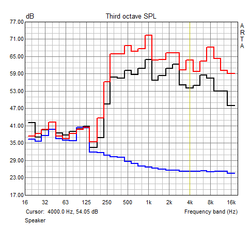
Lenovo equips the ThinkPad X260 with two 1-watt speakers. The resulting sound is richer than you might expect from such a small subnotebook. The volume is also sufficient for the majority of applications. Besides missing bass, voices could be more present as well.
Energy Management
Power Consumption
Lenovo's ThinkPad X260 turns out to be a frugal companion. The consumption is never higher than the competition, neither while idling nor under load. The comparison devices can consume more than 40 watts under load; one reason for that should be the modern Skylake platform of the X260.
The power adapter is sufficient with a nominal output of 45 watts.
| Off / Standby | |
| Idle | |
| Load |
|
Key:
min: | |
Battery Runtime
We can find one special feature when we look at the batteries. The test model is equipped with an internal as well as an external module (Power Bridge technology). Both have three cells and a capacity of 23 Wh. The technology has the advantage that the battery can be replaced when the notebook is running. There is also an optional external battery with a capacity of 48 Wh.
The manufacturer advertises a maximum runtime of 12 hours for our configuration. We wanted to check this with the tool Battery Eater and a result of 13:15 hours even surpasses the claim.
We use our Wi-Fi test for a more realistic runtime. The brightness is adjusted to around 150 cd/m² while we simulate web browsing. The test model turns off after around 6.5 hours. You should therefore choose an alternative battery option if you want the notebook to last a full business day.
The HP EliteBook 820 G2 is one hour behind, and the ThinkPad X250 at 5 hours cannot keep up with our test model, either.
We once again use the tool Battery Eater for the minimum runtime. This time we activate the "High Performance" power profile and start the Classic Test. The ThinkPad shuts down after a very solid runtime of 2 hours and 40 minutes.
| Battery Runtime - WiFi Websurfing | |
| Lenovo ThinkPad X260-20F60041GE | |
| HP Elitebook 820 G2-J8R58EA | |
| Lenovo ThinkPad X250-20CLS06D00 | |
Pros
Cons
Verdict
"Optimized for Business". Lenovo uses these words to describe the new Lenovo ThinkPad X260. We can confirm this statement in many respects. This starts with the chassis, where we meet a good amount of build quality and sturdiness. The certified military standards ensure a certain resistance against external forces, which are realistic in the business environment. We can still find some smaller build quality issues, despite the high price. Notebooks in this class are primarily designed for office applications, and Lenovo sets the bar quite high in this respect. Except for some small things, the keyboard pretty much meets our expectations for a business notebook. The touchpad on the other hand could still be improved.
Next, we evaluated the IPS display, which convinced with its matte surface and the pretty good picture quality. The resolution is unfortunately quite low and the brightness just average.
A look inside the review model shows a solid hardware package. There is unfortunately only one DDR4-RAM slot, so you can only use a single-channel configuration. All in all, however, the system performance was convincing. If you need even more power, you will have to pay more and get a higher-end SKU. Besides the decent emissions, we are also convinced by the Power Bridge technology. It uses two batteries, so one can be replaced "on the fly".
Lenovo offers a solid and successful 12.5-inch business notebook in general. Our review configuration suffers from some issues, though. We will have to wait and see if other configurations can get a better rating.
Depending on your personal preferences in the individual sections, it might be a good idea to take a closer look at the competition. The Dell Latitude 12 E7250, for example, comes with a brighter display.
Lenovo ThinkPad X260-20F60041GE
- 03/10/2016 v5 (old)
Nino Ricchizzi



























